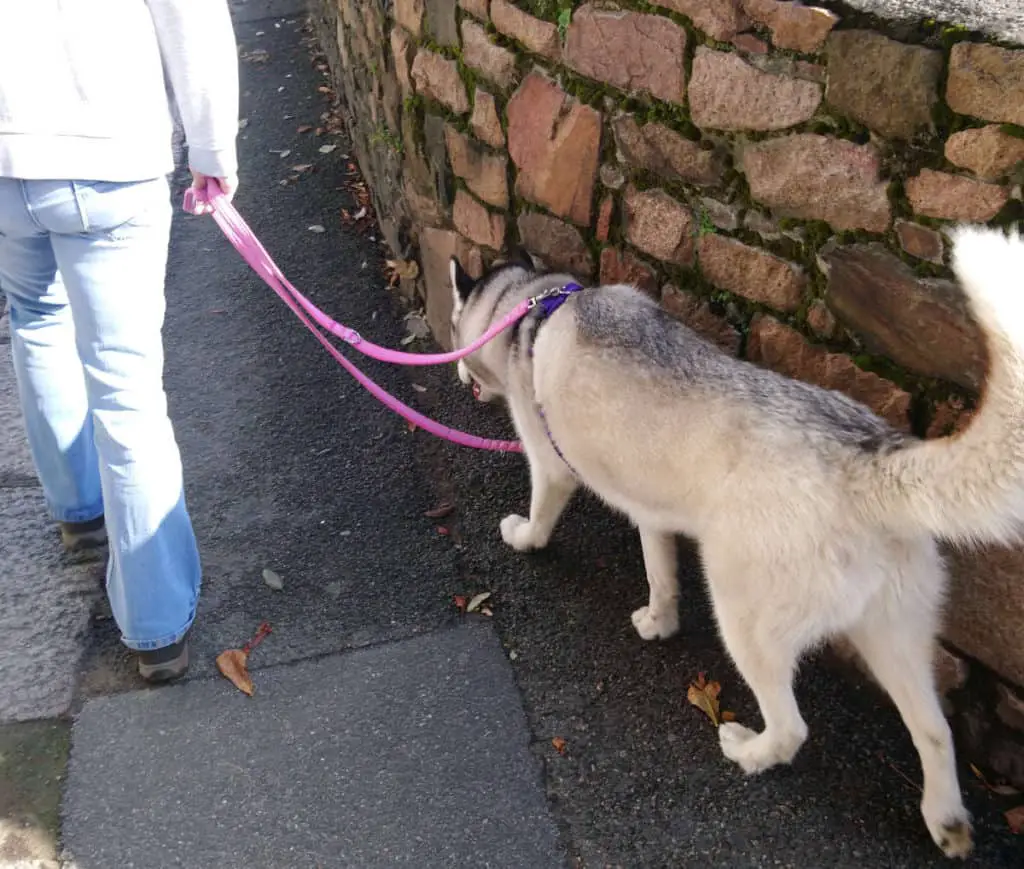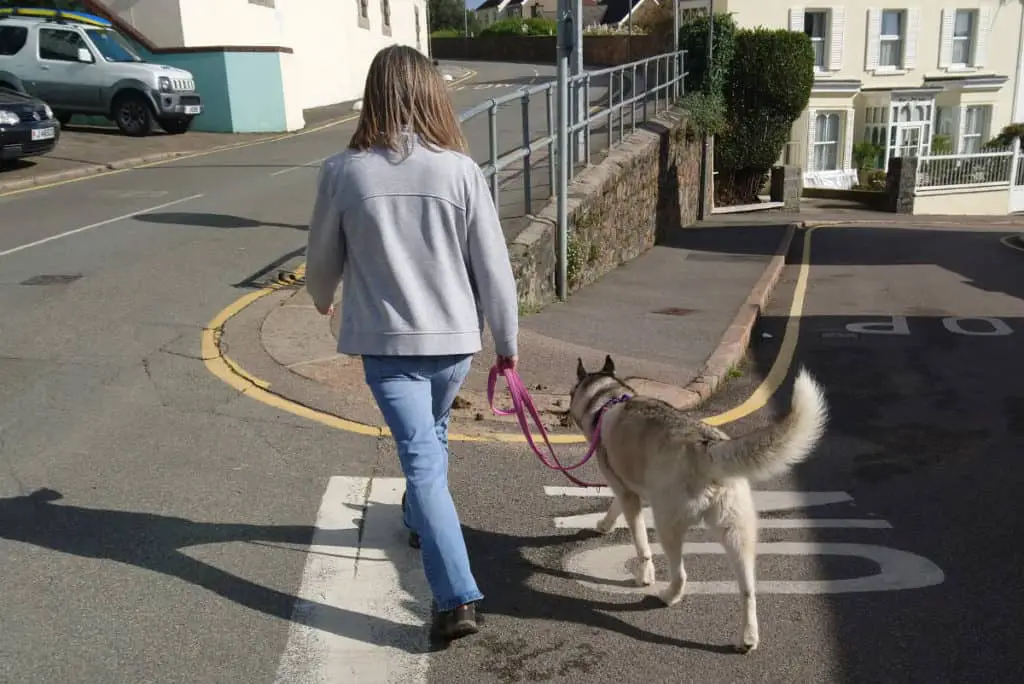Huskies are beautiful dogs. Sleek, graceful, and strong. Bred to run and pull sleds for long distances, with excellent stamina. So it’s only natural for them to pull when they are on-lead. But Can You Teach a Husky Not to Pull on Lead?
The answer is yes! They can be taught not to pull on-lead, in fact, they can be taught to loose lead walk, just like any dog.
Walking your dog, whether it’s a Husky, Chihuahua or Great Dane, should be a rewarding experience for you as well as your dog. There is nothing worse than trying to walk your dog and having your shoulder almost pulled out of its socket! Or in my own personal experience, a muscle pulled in my shoulder by my husky Luna when she was only 4 months old.
The last thing you want is to dread walking your Husky because they are pulling and dragging you where they want to go. Huskies are curious and playful by nature, so they want to explore everywhere and everything. Even if it means dragging you across a busy road because something on the other side has caught their attention.
It will take a lot of time and practice to get your Husky to loose lead walk, there are no shortcuts, but in the long run, it will make your walks a lot more pleasant for you and your Husky.
Husky Training
Huskies aren’t people-pleasing dogs, they are strong-willed and independent. If you want a Husky to cooperate with you then you need to make it worth their while and be prepared to put in a LOT of hours training.
You need to find a reward that your Husky really likes and will happily cooperate for. With our Husky Luna, in the beginning, it was cheese. A little bit of cheese goes a long way. Now I use kibble for walking and save the cheese for recall when I want her to come back. Cheese is a high-value reward in our house.
The training needs to be consistent, which means that whoever is walking your Husky needs to be doing the same thing. Your Husky has to learn the rules of being on-lead no matter who is holding the lead. If you and your partner will take turns walking your Husky, it’s a good idea to walk together a few times and agree on how to walk your Husky so you are both doing the same thing.
When we first started training our Husky Luna, I didn’t think that our children (11 & 12 years old in 2019) would ever be able to walk her. But perseverance, consistency, and patience have paid off and they are both able to walk her loose lead, with either me or my husband with them. I think they are still a bit too young to walk her without one of us present.
I believe in Force-Free Positive Reinforcement Training. We always reward the behavior that we want. This means that your dog associates good things with a certain behavior making it want to repeat the desired behavior.
In the case of walking on-lead whenever Luna pulled we just stopped until she stopped pulling. Once the lead relaxed then we would start walking again. When she pulled again, we stopped walking again and waited until the lead was relaxed. Quite a few times we would turn around and start walking back the way we came. She eventually learned that if she pulls she won’t go far.
After a while, your Husky will realize that in order to go forward or where it wants to go it must not pull on the lead. In the beginning, it takes a very long time to get anywhere, so make sure you have plenty of time for the walks. There is no need for you to pull on the lead, stopping and standing still will be enough, or changing direction and going back the way you came.

Loose Lead Walking Your Dog
Loose lead walking is the term used when a dog walks at your side and there is no tension on the lead. The lead is dangling between the human and the Husky. This is really the type of walking you should aim for. It means that your dog is calm and happy and you can both enjoy the walk.
The other thing we did with Luna was whenever she looked at us while we were walking she got a treat. This encourages your Husky to look at you because when they focus on you good things happen. You want your Husky to focus on you rather than the dog across the street. By rewarding every time they look at you it makes them want to look at you more.
This helps to encourage loose lead walking. Your Husky will be focusing more on you and less on pulling you towards something that has its attention.
It is also important to allow your Husky to have a good sniff at things that they want to sniff. Allowing sniffing is also a way to reward not pulling. Huskies love to sniff and sniffing is how your Husky makes sense of their environment. Sniffing is hugely enriching for dogs.
The added bonus in training your Husky to loose lead walk is that the extra training allows you to build and strengthen your bond. That in itself is worth the extra time and patience it takes to learn to loose lead walk.
How do I loose lead walk my dog?
Loose lead walking takes time to learn, for you and your Husky. Once you have the hang of it, it takes walking to a whole new enjoyable level.
There are some simple steps to loose lead walking, and you will repeat them every time you take your Husky for a walk:
- Make sure you have plenty of time for the walk – you won’t get very far in the beginning
- The second your Husky pulls stop walking, do not take one step.
- Stand still and hold the lead firmly so your Husky can’t go far – be prepared to wait for a few minutes until your Husky looks at you and relaxes the lead.
- When you have your Huskies focus on you and the lead is relaxed then walk.
- If your Husky doesn’t focus back on you then turn and start walking back the way you came.
- Whilst walking and your Husky isn’t pulling say ‘yes’ or ‘good boy/girl’ whatever your praise word/phrase is and give a treat.
- Repeat steps 1-5 as often as necessary.
There were times that I walked in a loop backward and forwards for what seemed like an eternity. I must have looked hilarious walking up and down the same part of the path for 20 minutes at a time.
It’s also a good idea to begin in a relatively calm environment and then gradually increase distractions. This isn’t always possible, so be armed with some high-value treats!
Do I need special equipment to loose lead walk my dog?
When you first start training on-lead walking a 2-point harness and a double-ended lead is a great investment. A 2-point harness has a ring on the front and a ring on the back of the harness which you then attach one end of the lead to the front and the other end of the lead to the back. The lead then creates a loop. You will also need your Huskies’ favorite treats.
The harness that you choose should be a good fit and also allow free shoulder movement for your Husky. An ill-fitting harness can cause problems later on for your Husky.
When you hold the lead but most of the pressure on the part of the lead which goes to the front of the harness on the chest and try to keep the part of the lead connected to the back of the harness slack. This is tricky and does take time to get the hang of.
You want to keep the pressure off the back of the harness. Huskies are bred to pull and will instinctively pull against any pressure from the back of the harness. This is why 2-point harnesses are great for training a Husky not to pull on the lead.
You may be wondering what the point of the back ring is, because if the pressure is mainly used at the front of the harness, then it seems unnecessary. However, once you become accustomed to the 2-point harness and double-ended lead you can then begin to use the back ring of the harness to indicate the direction for your Husky, ie. Left and right by applying a little bit of pressure either to the left or right.
What I really like about the 2-point harness is that when your Husky pulls they are actually turned around to face you going in the completely opposite direction from the one that they intended. This design really helps them learn that pulling is counter-productive.
When you are training your Husky to loose lead walk you should avoid extendable leads. They just don’t give you enough control and the Husky will instinctively pull against it. Plus extendable leads can jam or snap – my girl has destroyed a couple of them running on the beach.

Harness or collar for walking my dog?
I think that when you start training your Husky to walk on-lead that a harness is definitely more beneficial than a collar for walking. A collar may be fine once your Husky is well trained in loose lead walking but in the beginning, too much damage can be done because of the excessive pulling.
A harness provides a force-free way of training without unnecessary harm to your dog. And a Husky is strong-willed enough to pull against a collar causing itself harm to get where it wants to go.
A lot of people think that dog’s necks are a lot stronger than ours and can withstand pulling and jerking on their collar. Recent studies are now showing that dog’s necks are more similar to our own than we previously thought and serious damage can be caused by collar lead walking.
Pulling and jerking on a dog’s collar not only chokes them but can cause injury and damage to their trachea and their necks. As well as this it can also cause damage to their vertebrae and their nerves. Petmd.com recommends using a harness to walk your dog because of the damage collar lead walking can cause.
Even though our Husky Luna can loose lead walk, we still use her 2-point harness with the double-ended lead. I feel more confident when walking her with this, as I will have a bit more control if she is spooked or takes it in her head to run across a busy street.
Another bonus of the double-ended lead is that when we are in a park where dogs aren’t allowed off-lead, the double-ended lead can be used as an extra-long lead, giving her a bit more freedom to explore.
I rarely use an extendable lead because it has to be attached to the back ring of the harness. This encourages the dog to pull. When the extendable lead reaches its limit the dog is then jerked backward. This jerking motion can cause injuries to the dog’s neck and back, not to mention the shoulder wrenching the human at the other end receives. Even though I have attached a bungee to the end of my extendable to reduce the risk of injury, there is still a slight jerking motion that could harm the dog. I would never consider attaching an extendable lead to a collar!
Good luck with training your Husky and I hope this article was useful.
Before you go, you may find these articles interesting:
History of The Siberian Husky to Help Understand Their Traits

Leave a Reply